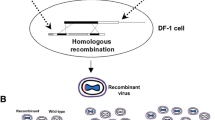Abstract
The complete genome of Marek’s disease virus (MDV) strain GX0101, which was integrated with the LTR sequences of REV, was cloned in Escherichia coli as a bacterial artificial chromosome (BAC). BAC vector sequences were introduced into the US2 locus of the MDV genome by homologous recombination. The viral DNA containing the BAC vector was used to transform Escherichia coli strain of DH10B. Then the recombinant virus was successfully rescued by transfection of the recombinant BAC DNA into primary chicken embryo fibroblast (CEF). This BAC viral clone was named bac-GX0101. When the reconstituted virus was inoculated into 1-day-old birds, visceral tumors could be detected as early as 62 d post infection. There was no difference in growth ability and pathogenicity to birds between the BAC derived virus and its parental virus. The BAC derived virus maintained its oncogenicity and immunosuppressive effects. In conclusion, the complete genome of GX0101 strain was successfully cloned into BAC and the infectious clone was rescued. With the powerful BAC manipulation system, the infectious clone will provide a useful tool for further understanding the functional roles of the inserted REV-LTR sequence in the GX0101 strain of MDV.
Similar content being viewed by others
References
Isfort R, Jones D, Kost R, et al. Retrovirus insertion into herpesvirus in vitro and in vivo. Proc Ntal Acad Sci USA, 1992, 89: 991–995
Davidson I, Borenshtain R. In vivo events of retroviral long terminal repeat integration into Marek’s disease virus in commercial poultry: Detection of chimeric molecules as a marker. Avian Dis, 2001, 45: 102–121
Zhang Z, Cui Z. Isolation of recombinant field strains of Marek’s disease virus integration with reticuloendotheliosis virus genome fragments. Sci China C-Life Sci, 2005, 48: 81–88
Witter R L, Silver R F, Lee L F. New serotype 2 and attenuated serotype 1 Marek’s disease vaccine viruses: Selected biological and molecular characteristics. Avian Dis, 1987, 31: 829–840
Schumacher D, Tischer B K, Fuchs W, et al. Reconstitution of Marek’s disease virus serotype 1(MDV-1) from DNA cloned as a bacterial artificial chromosome and characterization of a glycoprotein B-negative MDV-1 mutant. J Virol, 2000, 74: 11088–11098
Petherbridge L, Homes K, Baigent S J, et al. Replication-competent bacterial artificial chromosomes of Marek’s disease virus: Novel tools for generation of molecularly defined herpesvirus vaccines. J Virol, 2003, 77: 8712–8718
Petherbridge L, Brown A C, Baigent S J, et al. Oncogenicity of virulent Marek’s disease virus cloned as bacterial artificial chromosomes. J Virol, 2004, 78: 13376–13380
Baigent S J, Petherbridge L, Smith L P, et al. Herpesvirus of turkey reconstituted from bacterial artificial chromosome clones induces protection against Marek’s disease. J Gen Virol, 2006, 87: 769–776
Zhao Y G, Petherbridge L, Smith L P, et al. Self-excision of the BAC cequence from the recombinant Marek’s disease virus genome increases replication and pathogenicity. Virol J, 2008, 5: 19
Cui H Y, Wang Y F, Shi X M et al. Construction of Marek’s disease virus serotype 814 strain as an infectioous bacterial artificial chromosome. Chin J Biotech, 2008, 24: 569–575
Morgan R W, Cantello J L, McDermott C H, et al. Transfection of chicken embryo fibroblasts with Marek’s disease virus DNA. Avian Dis, 1990, 34: 345–351
Muyrers J P, Zhang Y, Stewart A F, et al. Rapid modification of bacterial artificial chromosomes by ET-recombination. Nucleic Acids Res, 1999, 27: 1555–1557
Narayaman K, Williamson R, Zhang Y, et al. Efficiant and engineering of a 200 kb beta-globin human bacterial chromsome in E. coli DH10B using an inducible homologous recombination system. Gene Ther, 1999, 6: 442–447
Sambrook J, Fritsch D F, Maniatis T, et al. Molecular cloning: a laboratory manual. Cold Spring Harbor: Cold Spring Harbor Laboratory Press, 1989
Lee L F, Liu X, Witter R L. Monoclonal antibodies with specially for three different serotypes of Marek’s disease viruses in chickens. J Immunol, 1983, 130: 1003–1006
Sun S H, Cui Z Z, Sun A J, et al. Comparisons of Preventive Effects of Maternal Antibody on Immunosuppression Induced by Homologous and Heterologous Reticuloendotheliosis Viruses. Acta Veterinaria Et Zootechnica Sinica, 2007, 38: 488–492
Author information
Authors and Affiliations
Corresponding author
Additional information
Supported by the National Natural Science Foundation of China (Grant No. 30671571) and BBSRC China Partnering Award (Grant No. CPA1740)
About this article
Cite this article
Sun, A., Lawrence, P., Zhao, Y. et al. A BAC clone of MDV strain GX0101 with REV-LTR integration retained its pathogenicity. Chin. Sci. Bull. 54, 2641–2647 (2009). https://doi.org/10.1007/s11434-009-0364-3
Received:
Accepted:
Published:
Issue Date:
DOI: https://doi.org/10.1007/s11434-009-0364-3




